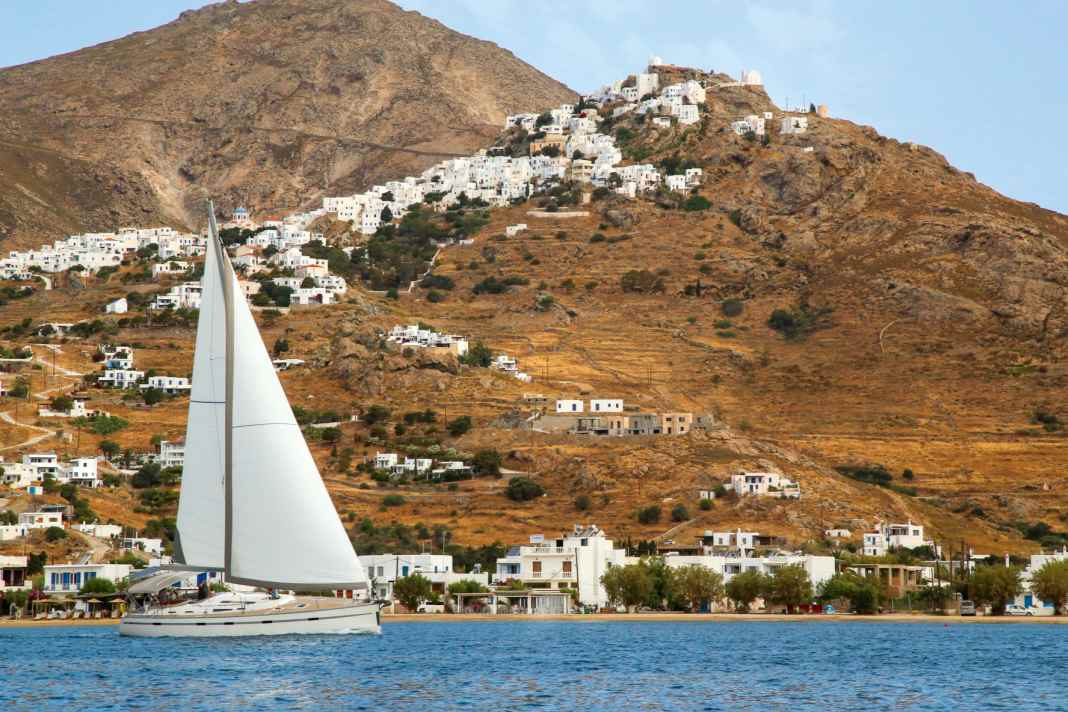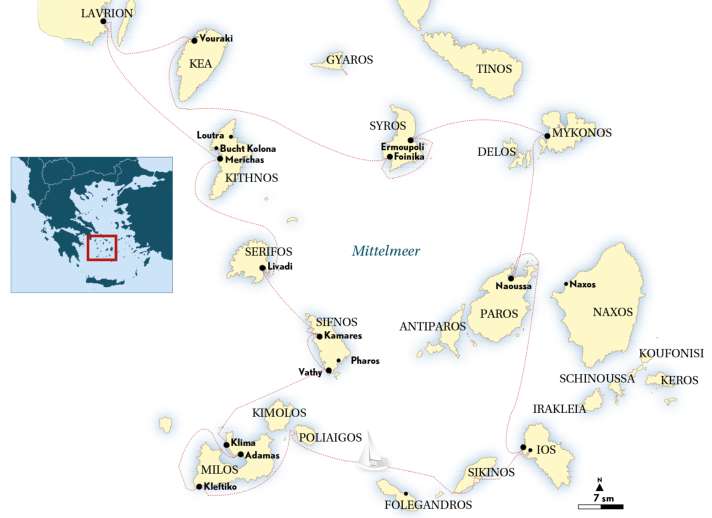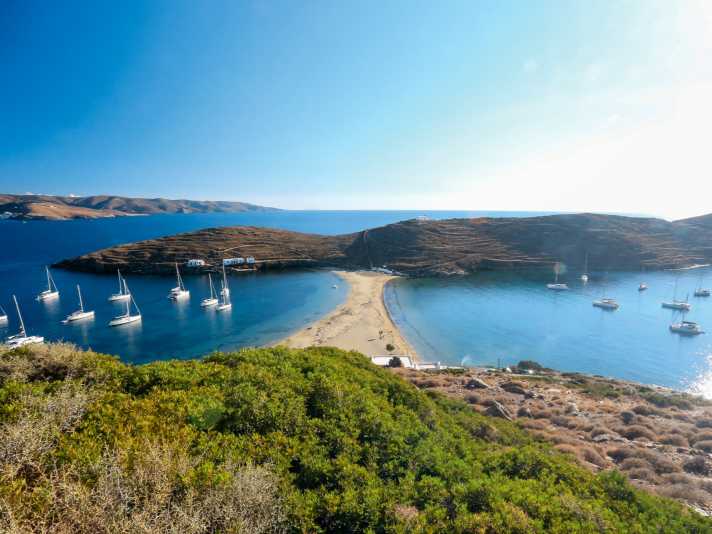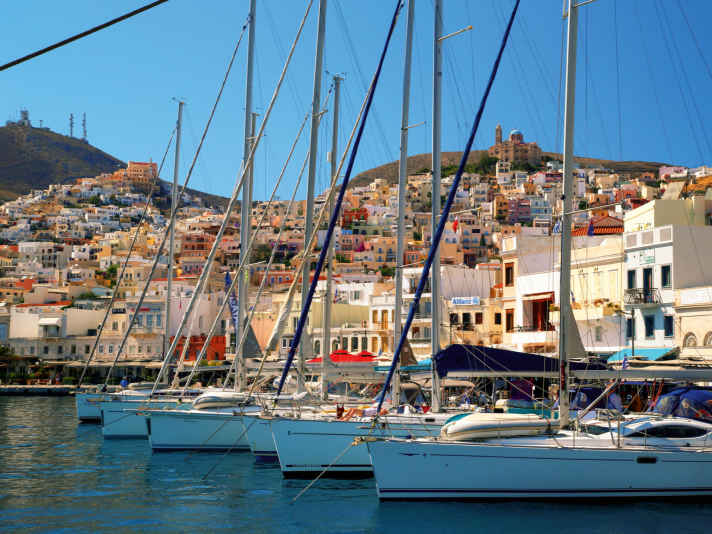Travelling: Beating Greece to the punch - Cyclades in the low season






Beating the Meltemi was the idea. Simply avoid the less windy, hot, full peak season and come at the end of May, beginning of June instead. Gentle thermal gliding, that was the plan. But fiddlesticks! As soon as we leave Lavrion, in the channel between Kea and the mainland, the wind blows from the north-east, the typical Meltemi direction, at 22 to 30 knots. Whitecaps, high waves. Luckily, we're sitting on a proud 55-foot boat, which is a pleasure to sail out of. However, things change behind Kea's southern tip.
With the second reef in the main and the genoa, we sail wildly upwind to round the northern cape of Kythnos. Then the sheets open - and "Apollon" takes off: we fly towards Syros, the main island of the Cyclades, at double-digit speeds in places. After all, spring in the Aegean means being able to sail against the spray in shorts and a light oilskin jacket. Because every now and then, water from a wave breaking on the side of the boat sweeps across the deck. For a sailor in the Baltic Sea, it's almost like sweet summer bliss.
Also interesting:
There's no other way to put it: as the sun sets, we nail round the corner into Foinikas Bay on the west side of Syros. Sails furled and two surprises: great wind protection and plenty of anchormen. I am irritated. The Cyclades, the heart of the Aegean, at the end of May, you have the bays to yourself! At least that's how it used to be. But the area has long been booming. Word has got around that the Aegean is not yet as overcrowded as Croatia or the Balearic Islands. And that the mooring fees are incomparably favourable and the prices ashore are moderate.
Gentle glide over to Ermoupoli
We find a spot in the bay. We quickly get the dinghy out of the practical stern garage, which looks like a mega yacht, mount the stylish electric outboard motor (practical judgement: top!), and then off to the taverna. The first 53 long nautical miles have been completed. When it comes to catering, everything is just as I remember it: friendly hosts, good and affordable food. The prices are lower than in Germany.
The next morning, the wind and weather are just as they should be for the time of year: the Aegean lies still in the sun like a steel-blue cloth, a breeze blows across the deck. There you go!
And so it's a gentle glide over to Ermoupoli, the metropolis of the Cyclades and the centre of the Aegean. With around 11,000 inhabitants, it is the largest city on the islands and an economic and cultural heavyweight. But above all: not yet overrun by tourism, although there is every reason to be. Ermoupoli stretches spectacularly over two steeply rising mountain ridges, the crests of which are adorned with several churches, surrounded by a winding old town centre.
Even the approach is a spectacle. Also because of harbour master Thanasis. He stands on the pier in a brightly coloured outfit and calls over: "Skipper, a lot of chain for your anchor, much swell from the ferries here! Leave more room to your side!" A harbour master who helps crews to moor is not a matter of course in Greece. So, despite being only six metres deep, we lay around 60 metres of chain and pull up to the pier with a good one and a half metres of space between us and our neighbour.
Thanasis takes the stern lines and gives more tips: "When the fast ferries are sailing, there's a lot of swell here. Set your chain really well, fender off carefully, and when you get off the boat, raise the gangway and keep as much distance as possible with the stern lines - welcome to Syros!" We chat a bit about the harbour, the island and then receive the bill: 8.53 euros in demurrage for a 55-foot boat. Plus a 15 euro consumption card for water and electricity. That would probably be the moment that brings tears to the eyes of Croatian sailors. In Dubrovnik we would pay 210 euros!
Too few berths on Mykonos
That leaves more money for a stroll through Syros' old town. It's had a makeover since our last visit. The beautiful old houses are being renovated everywhere, mega yachts are moored on the large pier and the many cafés in the side streets are much more chic. You can tell that things are going well in Greece and the locals are investing. The Aegean is becoming chic in many places.
However, the capital is not as touristy as the Cyclades hotspots Mykonos or Santorini. Syros is still firmly in the hands of the locals, not the tourists. There are small craft businesses and factories that produce things for everyday life. There is also a large shipyard, infrastructure and shops that are needed and function even in winter.
The next stop is intended as a contrasting programme: Mykonos. For years, every skipper I've met has told me: too touristy, too crowded! It was really crowded on my last visit, but an evening in Little Venice was enough to pick up any crew, wasn't it? To put it to the test, we set off on the crossing with the engine in absolute calm. There's another reason for us to visit the island: Mykonos Farmers. George Syrianos' family are third-generation sheep and goat farmers and also run a cheese dairy that teaches visitors about the traditional production of these products. And on the jet set and party island of all places! Let's take a look.
What has always been true of Mykonos: there are too few moorings. The marina is dreary and dusty, and on top of that you have to book in advance. The charter company will do this on request. But strategically it is the safest place. The large anchorage south of the city is very crowded and deep, and it's five kilometres to the city.
Visit to a cheese dairy
Before strolling through the famous old town with its row of harbours at the foot of the windmills, we visit the cheese dairy. A little further inland, the owner explains how he ended up farming on the most touristic island in the Cyclades: "My family has had sheep and goats and made cheese for generations. But as it happens, as a young man I wanted to leave. I studied electrical engineering in Athens. Then I set up my own company and ran a business on Mykonos for 25 years when the island was booming and growing."
But at some point, George Syrianos realised that he was burnt out. That's when he remembered the farming that his ancestors had done. "Everyone said I was crazy, that I should build a hotel, it was the easiest way to get rich! But I wanted to do something for myself."
For months, he worked with his father and the animals, making cheese from their milk. "It was exhausting, but I realised that I was regaining my strength and my mind was becoming clear again." So he founded the cheese dairy. Today, he offers visitors the opportunity to learn exciting things about the island and the production process. For example, that only sheep and goats can survive on the Cyclades without supplementary feeding. That the cheese used to be salty so that it could be preserved without refrigeration. Or that the lambs in Greece are born in August and not around Easter like here. This is due to the mild Greek winter.
George Syrianos goes on and on: the classic cheese from Mykonos is the rather flavoursome Kopanisti, but only the locals know it. You can also use lemon instead of rennet to make cheese from milk. It's exciting to listen to him. Mykonos Farmers is the place to go if you fancy a taste of authentic Greece.
In any case, we leave George Syrianos with plenty of new knowledge - and a rucksack full of cheese. Arriving in Mykonos Town, the contrast could hardly be greater. Firstly, the taxi is forever struggling through the overcrowded streets, then, after getting out, we push our way through the crowds. We are lucky: there is only one cruise ship anchored in front of the harbour. In high season, there are up to eight.
Despite everything, the colourful row of houses by the sea in front of the windmills is still beautiful. Good-humoured guests from all over the world sit by the sea to lounge music, sipping outrageously expensive drinks. But the parade of the masses continues there too. The crew see it all as stressful and no one can really enjoy it. All the restaurants and bars are bursting at the seams. What will it be like in the main holiday season? Back on board, we all agree: Mykonos doesn't have to be without the detour to George's farm.
Naoussa is simply beautiful
So we continue south towards Paros. But it's tough again. In the morning, the wind is almost nil, and only in the afternoon does a slight thermal build up as the sun heats up the islands and the air rises. This means wind only from 2 or 3 p.m., which in turn means a late arrival at the destination. Then it's calm again at night. Sailing in the early season has its own rules. As if in compensation, two striped dolphins play around the boat in the smooth water.
The island of Paros has one of the most beautiful small town harbours in the area: Naoussa in the north-east. Cafés and restaurants are lined up around the tiny fishermen's basin, where you can enjoy a wonderful view of the sea at sunset under bougainvillea. Unfortunately, the small marina next to it is somewhat dilapidated and only has a few berths. However, it is an excellent place to anchor, especially now that there is no meltemi in the bay. The turquoise water, the pretty silhouette of the town with its white cube houses, the church above the centre, the rolling hills to the right - simply beautiful!
Once you have crossed over by dinghy, Naoussa delivers even more than the town promises visually: the winding alleyways are lined with cosy cafés. Some of them sit right on the water. The people are friendly and relaxed. We noticeably often meet Americans, not only here but also on the other islands. The charter base manager of Olympic Yachting later tells us why this is the case: the tourism minister of Greece, who studied in the USA, has arranged a co-operation with his colleague there. Now ten huge commercial aircraft from US metropolises land in Athens every day. It can be that simple.
The crew quickly agrees: Paros is the perfect alternative to Mykonos - at least as beautiful, but the tourism is much more moderate. The prices on Paros haven't exploded yet either. So it's better to spend a day here.
From island to island in calm winds
We use this to visit a winery. Alongside Santorini, Paros is one of the islands in the Cyclades that is known for its wine-growing. The Moraitis family winery is just a few minutes' walk from the town. We take a guided tour and Thonos Sponopoulos shows us the cellar and vineyards. He explains: "The Moraitis family are fourth-generation winegrowers. They were also traders. The current owner's grandfather produced wine himself, bought more wine from other islanders, filled it into barrels and sailed from island to island in a wooden kaiki, the old Greek fishermen's workboat. There he supplied tavernas and residents, tapping directly from the barrel." Even today, winegrowing is one of Paros' most important sources of income alongside tourism.
"Paros is one of the Cyclades islands with a relatively large amount of groundwater, which is good for the wine," explains Thonos Sponopoulos. "The vines need about five years for their roots to reach this water deep in the ground." Due to the strong winds in summer and the scirocco in winter, the vines can only be grown half as high as elsewhere. They also rely on old local varieties that are adapted to the climate. "We mainly grow Monemvasia, but there are also red wines such as Mandilaria." Thonos Sponopoulos spends a good hour telling us exciting things about winegrowing. It flies by.
During the following days, we continue to wind our way from island to island in rather calm winds: to the steeply rising island of Ios with its fantastic old town on the mountain. To the uninhabited island of Poliagios with its dream anchorages. And from there to a highlight for which the little wind is ideal: the south coast of Milos. There is a short coastal strip called Kleftiko with steep, soft limestone cliffs. They are heavily eroded, columns and gates have formed. The scenery is spectacular, but the coast is only good for an anchor stop in calm conditions. So we motor across early in the morning in the calm.
The place really is beautiful. The rock needles tower 30 or 40 metres above the water surface, some of them are perforated; you can swim through some of the openings. The water is a particularly turquoise colour due to the limestone. A magical place - but only for a few hours: Around midday, hordes of excursion boats arrive. Too much for this natural idyll, so it's worth coming early!
Top islands on the way back: Sifnos and Serifos
We move to the main town of Adamas. Rather unspectacular with lots of ferry traffic and excursion boats. The short stop in front of the village of Klima with its colourful houses, which you can see as you enter the huge harbour bay, is more worthwhile. Now, at the southernmost point of the trip, it would actually be time to head back against the Meltemi from the north. But it is still a long time coming. We are gradually longing for it.
Two top islands await on the way back: Sifnos and Serifos. Sifnos is probably the most underrated and versatile island in the Cyclades. With Pharos, Vathi and the main town of Kamares, it has great destinations and two or three days are well invested here. We stop in the sleepy, circular anchorage bay of Vathi, which is surrounded by imposing mountain slopes. There are gusts of wind in Meltemi, but now it's as peaceful here as on an inland sea. Swimming, lunch in a taverna right on the beach, the scent of herbs drifting down from the slopes: Greek idyll.
The village of Kamares nestles at the foot of a steep cliff. The best place to anchor is in the shallow bay in front of it, with a panoramic view of the bustling little island town. In the evening, land-based tourists come here to dine with a sea view. If you like, take a ten-minute taxi ride to Chora, high up in the mountains. The village with its enormously steep alleyways full of restaurants, bars and shops is quaint and the view over the Aegean is phenomenal.
And so, at the end of the trip, a cosy equilibrium sets in: You have seen the many facets of the Cyclades and understand how different each island is. Hustle and bustle, cultural history on the one hand, magnificent scenery, sleepy island villages and great anchor bays on the other. If you want to experience all this without the stormy Meltemi, you can come early or late in the year, but then you have to pay for the relatively long distances between the islands with motor hours. Or sail more slowly in the afternoon. But as the Greeks say: "Siga, siga - slowly, slowly!"
Hotspots of the Cyclades

1. kithnos

The island is the first or last stop for most crews from Athens or Lavrion. If you want to anchor, you can do so beautifully in the double bay of Kolona on the north-western tip. There is a restaurant there with a dream view at sunset. Book early! An alternative harbour is Merichas a little to the south: a long pier, even showers, good shelter when the Meltemi is blowing. On the east coast, the small harbour of Loutra is a nice destination.
2. syros

The administrative centre of the region and an underestimated destination that is definitely worth a visit. Put in a lot of chain and anchor well. Keep your distance from your neighbours. Restaurant tip: the "Port" at Akti Papagoi 60 - original and good.
3. Naoussa on Paros

The winding old town is a dream. The harbour is a little choppy and partly shallow when the Meltemi is strong. However, there are good anchorages in the huge bay. Tip: the town of Parikia. Take a taxi to get there because of the choppy harbour.
4. ios

The best berths when entering the harbour are on the right, where the ferry swell is least disturbing. The old town on the hill is a favourite party location for many Brits. Gastro tip with a brilliant view: "Grandma's Restaurant"!
5th Milos

If you want to see the rocks of Kleftiko, it is best to round the island clockwise from the south. Only spend the night there when there is little wind. The main harbour of Adamas is well sheltered in Meltemi, avoid it when the wind blows from the south!
6 Sifnos

The most versatile island in the area: the sleepy bay of Vathi in the south-west is quaint, the main harbour of Kamares in the north-west is a great, lively holiday resort. Anchoring in the bay is nicer than lying on the noisy harbour pier.
7th Serifos

Good harbour, otherwise anchor far to the west in the bay with lots of chain, lots of stone to the east! An evening in the old town high up on the mountain is a must, the bus takes you up from the harbour (4 euros). Restaurant tip: the "Seriani"!
District information at a glance
Journey
Flights to Athens from many German airports cost around 400 to 500 euros. Transfer from there to Lavrion approx. 35 minutes for 50 euros.
Charter
We were travelling on a 14-year-old Bavaria 55 from the Greek family business Olympic Yachting. The company, which charters out around 20 boats (Jeanneau/Bavaria), won a YACHT survey for the best-maintained fleet in the Mediterranean (YACHT 7/2024). The ship was in top condition. This also applies to the new ships. The standard of equipment is high: solar panels, more powerful anchor winches, electric toilets with freshwater flushing, electric outboard motors, crew radio headsets for the jetty and much more. The boat costs 3,880 to 6,710 euros per week, depending on the season.
- More information: olympicyachting.com
Harbours & anchorages
Mainly municipal harbours, often with bow anchor and stern to pier. Water and electricity available, rarely sanitary facilities. The price level is by far the lowest in the European Mediterranean, often less than 10 euros plus approx. 10 to 20 euros for water and electricity consumption for 55 feet! Very good and many anchorages, often on sandy ground.
Wind & Weather
From June onwards, the Meltemi gradually builds up, which only slowly dies down again in September and often blows at 4 to 6 Beaufort. Strong winds of up to 8 Beaufort are possible for a few days. Due to the topography of the islands, it is significantly stronger regionally, there are many jet and cape effects and downslope winds on the mountainous sides of the islands, for example south-east of Kos.
Literature & Charts
- Rod Heikell: "Greek coasts", Edition Maritim69.90 euros.
- The best nautical charts for the area are the Greek pleasure craft charts from Eagle Ray

